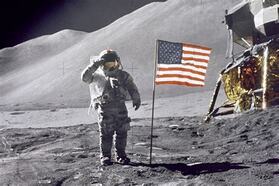 By M.P. Pellicer | Stranger Than Fiction Stories What is it about that moon that has so many countries seeking to land there after America first visited in 1969? 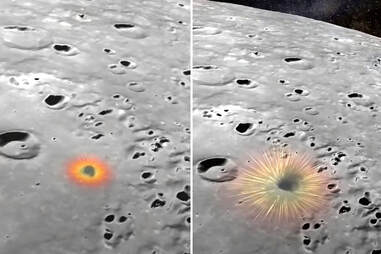 On March 4, 2022 a Chinese rocket plowed into the moon On March 4, 2022 a Chinese rocket plowed into the moon On March 4, 2022, a left over piece of a Chinese rocket that had been wandering in space for years hit the moon. It impacted on the far side near the Hertzsprung crater. First it was believed to be a piece of SpaceX Falcon 9 rocket, sent to monitor weather in 2015. Later it was confirmed it belong to China's Chang'e 5-T1 sent out in 2014, in order to test technology to be used to retrieve samples from the moon. China denied the rocket belonged to their space program, saying the 5-T1 had burned up when re-entering Earth's atmosphere. The denial was later explained as a confusion between missions. 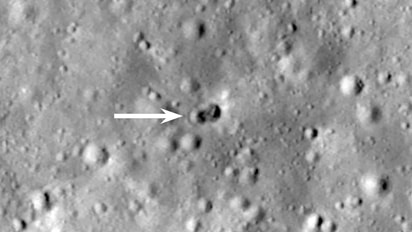 Double craters created on the moon surface after rocket debris crashed on March 4, 2022 (Source - NASA/Goddard/Arizona State University) Double craters created on the moon surface after rocket debris crashed on March 4, 2022 (Source - NASA/Goddard/Arizona State University) In June, 2022, the impact from the rocket created two, overlapping craters. One measures 59 feet and the other spans 52.5 feet. In 2021, NASA issued a report that details that there are over 500,000 objects about the size of a marble that can damage satellites and about 26,000 pieces of junk about the size of a softball or larger, orbiting the Earth. This is not the first piece of debris that has crashed into the moon. It's believed that in the future junk in space should be better tracked. On June 6, 2023, China launched a new, 3-person crew to the space station. They plan to put astronauts on the moon before 2030. 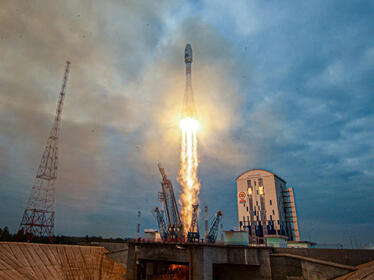 Soyuz-2.1b rocket with the moon lander Luna-25 takes off from a launchpad at the Vostochny Cosmodrome in Russia's Far East. (Source - Roscosmos State Space Corp) Soyuz-2.1b rocket with the moon lander Luna-25 takes off from a launchpad at the Vostochny Cosmodrome in Russia's Far East. (Source - Roscosmos State Space Corp) On August 23, 2023, India touched down on the moon's south pole; this was a second attempt after their first one failed four years before. A few days before Russia crash landed in their own attempt. Their mission was named Luna-25. It was Russia's first attempt to land on the moon in decades, since the Soviet Union fell. Both lunar landers were unmanned. The lunar south pole has frozen-water reserves, and the value in this is that it can be broken down into oxygen and hydrogen. This can be used as fuel to launch rockets to Mars without the pull of Earth's gravity. A few days later, Japan's first SLIM lunar module was to be launched on the H-IIA launch vehicle from Tanegashima Space Center. The lander is about the size of a food truck and it brought along a bus-size telescope. It also could have been the first launch since the failure of the new H3 rocket in March, 2023. It was canceled minutes before take off due to weather.  There are others who believe India's claim of landing on the moon is all fake. "First China and now India have successfully landed animations on the 'moon' and in upside down world you are expected to digest it all as fact despite precious little proof that these scientific 'accomplishments' are real. And in the case of India's moon mission, the animation on South Park is better." 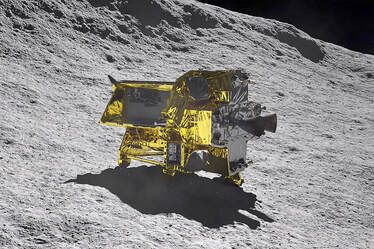 Artist's rendition of Japan's Smart Lander for Investigating Moon (SLIM) lander on the lunar surface. (Source - JAXA) Artist's rendition of Japan's Smart Lander for Investigating Moon (SLIM) lander on the lunar surface. (Source - JAXA) On January 18, 2024, Japan sent out their Smart Lander for Investigating Moon (SLIM) for a landing close to an equatorial moon crater named Shioli. Despite the success of landing it on the lunar surface, on January 22, 2024 it only had 12% battery power available. The SLIM spacecraft is dependent on solar cells, and once darkness falls, it cannot generate electricity. In its position, there are two weeks of darkness and two of light. So now it's a waiting until sunlight is available to energize it. SLIM is carrying two small rovers which it ejected before landing. It also has an infrared camera to study the geology. So far only about half of all attempts to land on the moon surface have succeeded.
0 Comments
Your comment will be posted after it is approved.
Leave a Reply. |
Stranger Than Fiction StoriesM.P. PellicerAuthor, Narrator and Producer Archives
July 2024
Categories
All
|
Stories of the Supernatural
- Stories of the Supernatural
- Miami Ghost Chronicles
- M.P. Pellicer | Author
- Stranger Than Fiction Stories
- Eerie News
- Supernatural Storytime
-
Astrology Today
- Tarot
- Horoscope
- Zodiac
-
Haunted Places
- Animal Hauntings
- Belleview Biltmore Hotel
- Bobby Mackey's Honky Tonk
- Brookdale Lodge
- Chacachacare Island
- Coral Castle
- Drayton Hall Plantation
- Jonathan Dickinson State Park
- Kreischer Mansion
- Miami Biltmore Hotel
- Miami Forgotten Properties
- Myrtles Plantation
- Pinewood Cemetery
- Rolling Hills Asylum
- St. Ann's Retreat
- Stranahan Cromartie House
- The Devil Tree
- Trans-Allegheny Lunatic Asylum
- West Virginia Penitentiary
- Paranormal Podcasts
"When misguided public opinion honors what is despicable and despises what is honorable, punishes virtue and rewards vice, encourages what is harmful and discourages what is useful, applauds falsehood and smothers truth under indifference or insult, a nation turns its back on progress and can be restored only by the terrible lessons of catastrophe."
- Frederic Bastiat
- Frederic Bastiat

Copyright © 2009-2024 Eleventh Hour LLC. All Rights Reserved ®
DISCLAIMER
DISCLAIMER
 RSS Feed
RSS Feed
















